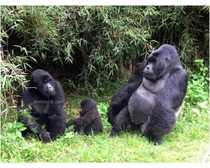Gorilla represents the largest of the living primates and is quite peaceful and sociable in nature. In this article, we bring for you some interesting facts and amazing information on gorillas.
Facts About Gorilla
Gorillas are largest of all the great apes and most powerful of all living primates- chimpanzees, gorillas, orangutangs and humans. They live in tropical and subtropical forests of Central Africa and are important seed dispersers in rain forest. Hence they play key role in the ecology of the forest systems. Gorillas mostly delve on plant foods: leaves, shoots, fruits, bulbs, bark, vines and nettles.In captivity, gorillas have displayed significant intelligence and have even learned simple human sign language. Read on to know more interesting facts and amazing information on critically endangered Gorillas.

Facts About Gorilla
Binomial Name: Gorilla beringei (Eastern Gorilla), Gorilla gorilla (Western Lowland Gorilla)
Kingdom: Animalia
Phylum: Chordata
Subphylum: Vertebrata
Class: Mammalia
Order: Primates
Family: Hominidae
Subfamily: Homininae
Genus: Gorilla
Species: G. gorilla (Western Lowland Gorilla), G. beringei (Eastern Gorilla)
Height: 165-183 cm (5 ft 5 in – 6 ft) male, 140- 152.4 cm (4 ft 7 in- 5 ft) female
Weight: 140–204.5 kg (310–450 lb) male, 100 kg (220 lb) female
Life Span: 35 years
Diet: Predominantly herbivore
Range: Central Africa, volcanic slopes of Rwanda, Uganda, and the Democratic Republic of Congo
Habitat: Tropical and subtropical forests, Dense forests, lowland swamps, marshes
Age of Sexual Maturity: Males at 7-8 years/ Females at 6-7 years
Gestation Period: 81/2 months, 209-251 days
Number of Offspring: One
Interesting & Amazing Information On Gorillas
- The arms of adult gorillas are 20% longer than their legs. They walk by using all the four limbs, supported by the knuckles.
- A mature gorilla can spread his arms 8 feet across and is as strong as 4 to 8 strong men, put together.
- A gorilla shares 97% of its biology with human beings. Its DNA is 97-98% identical to that of humansand it is the next closest living relative to humans, after the two chimpanzee species.
- The word ‘gorilla’ has been derived from the Greek word ‘Gorillai’, which literally means a ‘tribe of hairy women’.
- Gorillas used to inhabit a wrap of land that cut across central Africa, but the forests were diminished by ice age, divided them into three groups - the western lowland gorilla, the eastern lowland gorilla and the mountain gorilla.
- Gorillas come under the ‘Endangered Species’, with roughly 700 mountain gorillas remaining on earth. Nearly half of them live in the forests of Virunga Mountains, in Central Africa.
- Mountain gorillas have longer hair, shorter arms and are larger than their lowland cousins and other gorillas.
- Silverback gorilla is a mature adult male. The hair on his back turns silvery-gray when he becomes fully grown, at the age of 15.
- Gorillas can stand upright, but they don’t do it very often. They do it to chestslap, in which they beat an open cupped hand against their chest, making a loud sound, which can indicate aggression or excitement.
- Gorillas can climb trees, but are usually found on the ground, in communities of up to 30 individuals.
- Gorillas communicate with each other by using gestures, body postures, facial expressions, vocal sounds, chestslaps, drumming and odors. Although they cannot produce the sounds of human speech, they are capable of understanding spoken languages and can learn to communicate in sign language as well.
- Gorillas are very intelligent and they share with a full range of emotions: love, hate, fear, grief, joy, greed, generosity, pride, shame, empathy, and jealousy, with humans.
- Gorillas laugh when they are tickled and cry when they are sad or hurt. However, they cry with sounds, not tears.
- Gorillas can mate all round the year. The female produces one offspring about every fourth year.
- Gorillas are shy and peaceful, unless improperly disturbed. Human beings, who hunt the animal for meat (bushmeat) and trophies (in some parts of Africa), make its only natural enemy.
- Gorillas sleep about 13 hours each night and rest for several hours at midday. They build new sleeping nests every night, by bending nearby plants into a springy platform, usually on the ground or in low trees.
- A typical gorilla family includes one silverback - the strongest male and the undisputed leader; one immature male; three or four adult females; and three to six youngsters. Some groups are larger or smaller than this. Sometimes, the male gorillas travel alone or form bachelor groups.
- As a male gorilla matures, its skull develops a bony ridge, which makes its head dome-shaped.
- Gorillas can use tools for problem-solving purposes. For example, they can use a tree branch as a bridge, to cross muddy ground.


See also
More from iloveindia.com
- Home Remedies | Ayurveda | Vastu | Yoga | Feng Shui | Tattoos | Fitness | Garden | Nutrition | Parenting | Bikes | Cars | Baby Care | Indian Weddings | Festivals | Party ideas | Horoscope 2015 | Pets | Finance | Figures of Speech | Hotels in India : Delhi | Hyderabad | Chennai | Mumbai | Kolkata | Bangalore | Ahmedabad | Jaipur
- Contact Us Careers Disclaimer Privacy Policy Advertise With Us Lifestyle Sitemap Copyright iloveindia.com. All Rights Reserved.




